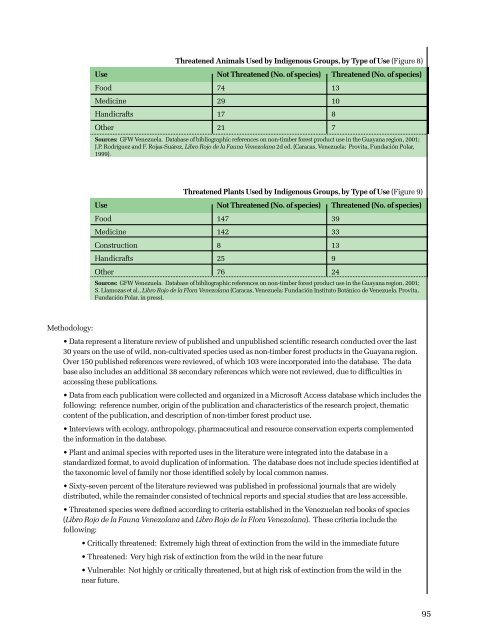Usar pâgs xvii-134 - ResearchGate
Usar pâgs xvii-134 - ResearchGate
Usar pâgs xvii-134 - ResearchGate
Create successful ePaper yourself
Turn your PDF publications into a flip-book with our unique Google optimized e-Paper software.
Threatened Animals Used by Indigenous Groups, by Type of Use (Figure 8)Use Not Threatened (No. of species) Threatened (No. of species)Food 74 13Medicine 29 10Handicrafts 17 8Other 21 7Sources: GFW Venezuela. Database of bibliographic references on non-timber forest product use in the Guayana region, 2001;J.P. Rodríguez and F. Rojas-Suárez, Libro Rojo de la Fauna Venezolana 2d ed. (Caracas, Venezuela: Provita, Fundación Polar,1999).Threatened Plants Used by Indigenous Groups, by Type of Use (Figure 9)Use Not Threatened (No. of species) Threatened (No. of species)Food 147 39Medicine 142 33Construction 8 13Handicrafts 25 9Other 76 24Sources: GFW Venezuela. Database of bibliographic references on non-timber forest product use in the Guayana region, 2001;S. Llamozas et al., Libro Rojo de la Flora Venezolana (Caracas, Venezuela: Fundación Instituto Botánico de Venezuela. Provita,Fundación Polar, in press).Methodology:• Data represent a literature review of published and unpublished scientific research conducted over the last30 years on the use of wild, non-cultivated species used as non-timber forest products in the Guayana region.Over 150 published references were reviewed, of which 103 were incorporated into the database. The database also includes an additional 38 secondary references which were not reviewed, due to difficulties inaccessing these publications.• Data from each publication were collected and organized in a Microsoft Access database which includes thefollowing: reference number, origin of the publication and characteristics of the research project, thematiccontent of the publication, and description of non-timber forest product use.• Interviews with ecology, anthropology, pharmaceutical and resource conservation experts complementedthe information in the database.• Plant and animal species with reported uses in the literature were integrated into the database in astandardized format, to avoid duplication of information. The database does not include species identified atthe taxonomic level of family nor those identified solely by local common names.• Sixty-seven percent of the literature reviewed was published in professional journals that are widelydistributed, while the remainder consisted of technical reports and special studies that are less accessible.• Threatened species were defined according to criteria established in the Venezuelan red books of species(Libro Rojo de la Fauna Venezolana and Libro Rojo de la Flora Venezolana). These criteria include thefollowing:• Critically threatened: Extremely high threat of extinction from the wild in the immediate future• Threatened: Very high risk of extinction from the wild in the near future• Vulnerable: Not highly or critically threatened, but at high risk of extinction from the wild in thenear future.95
















